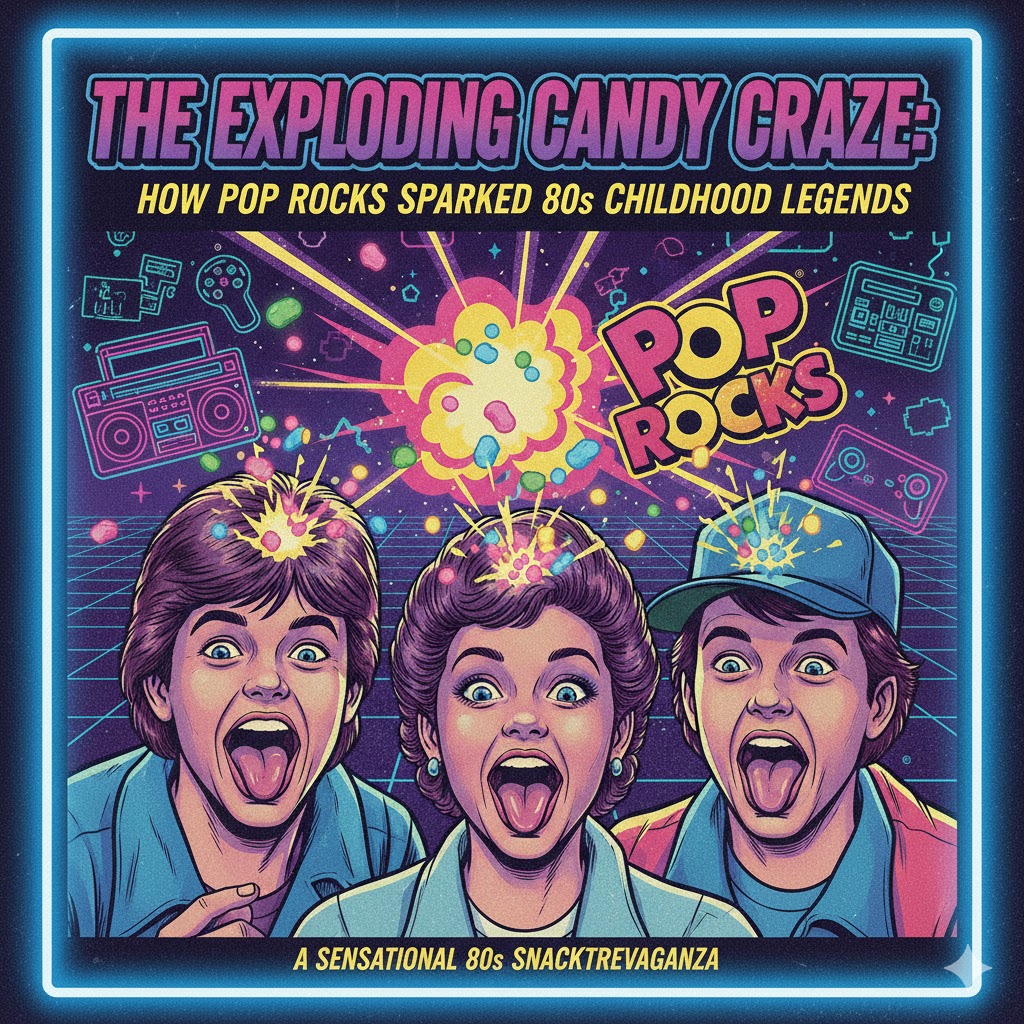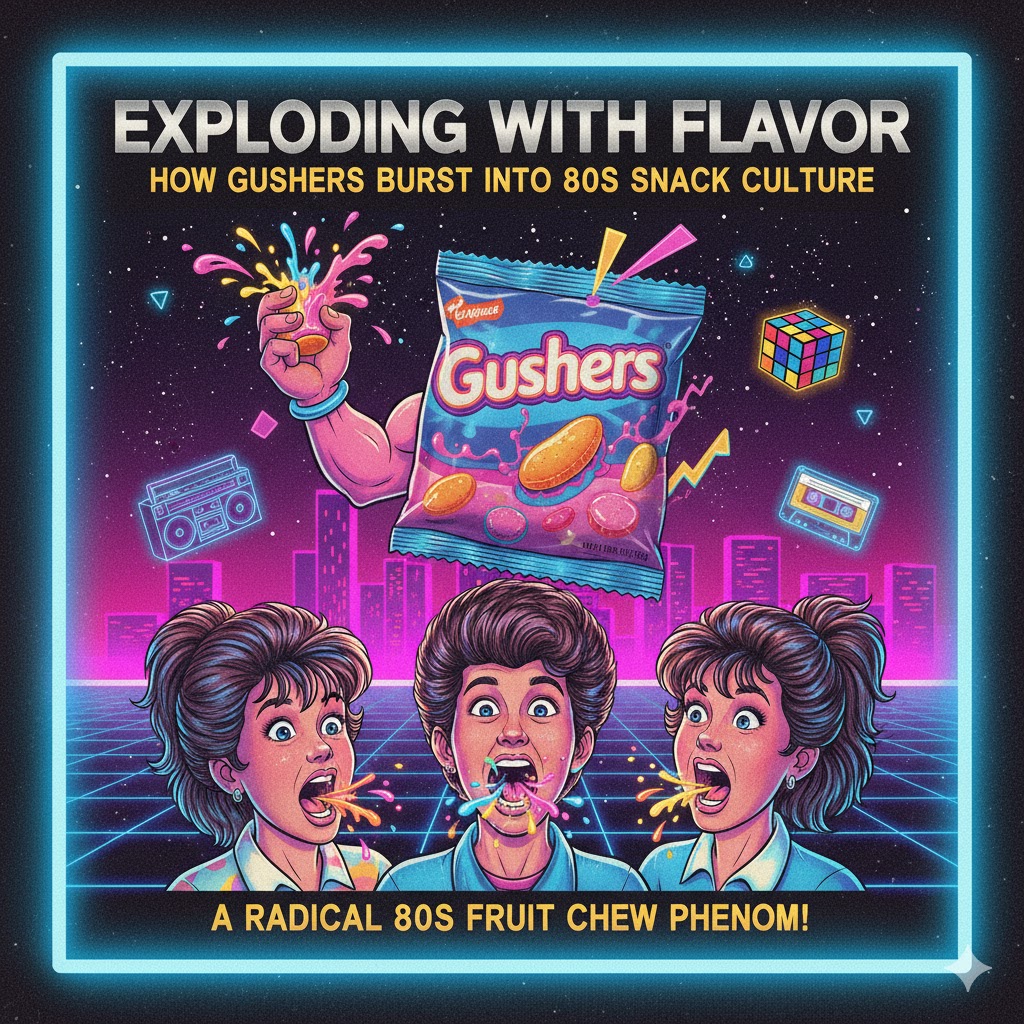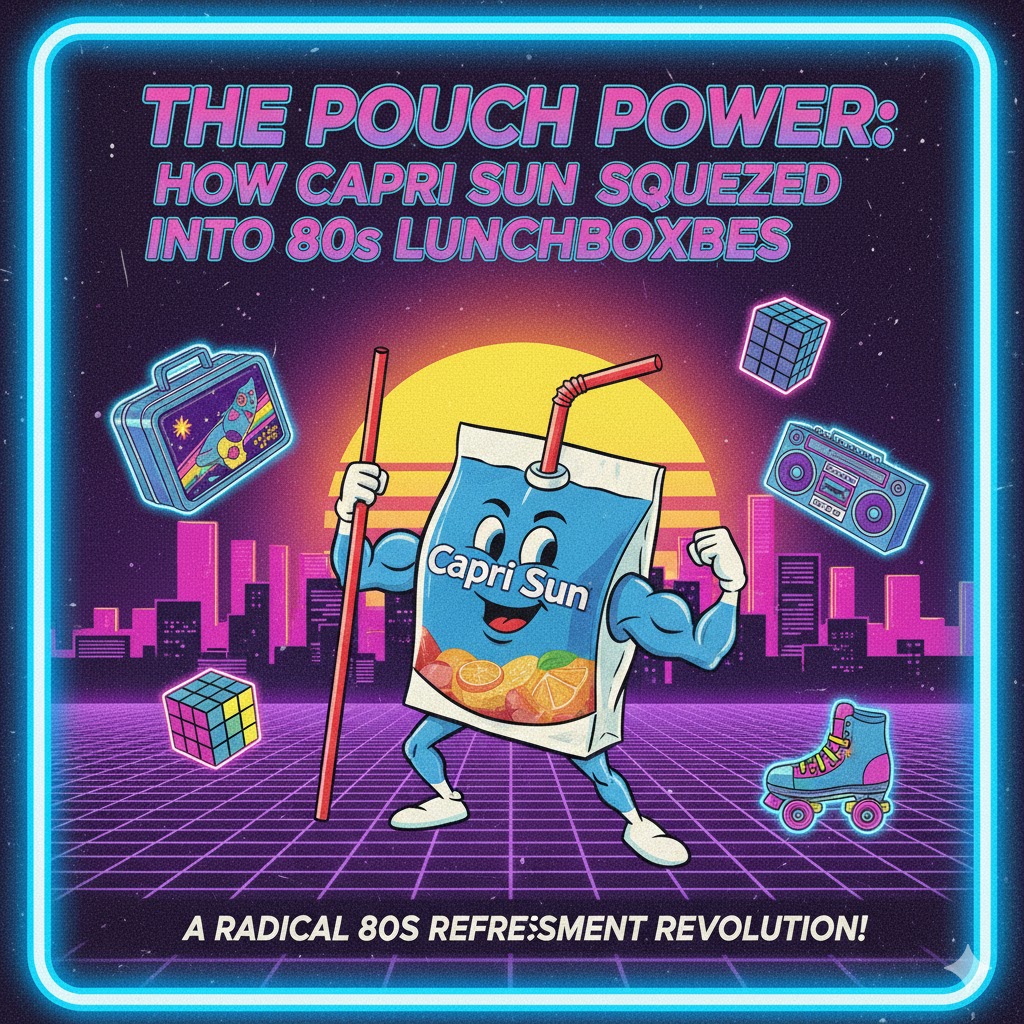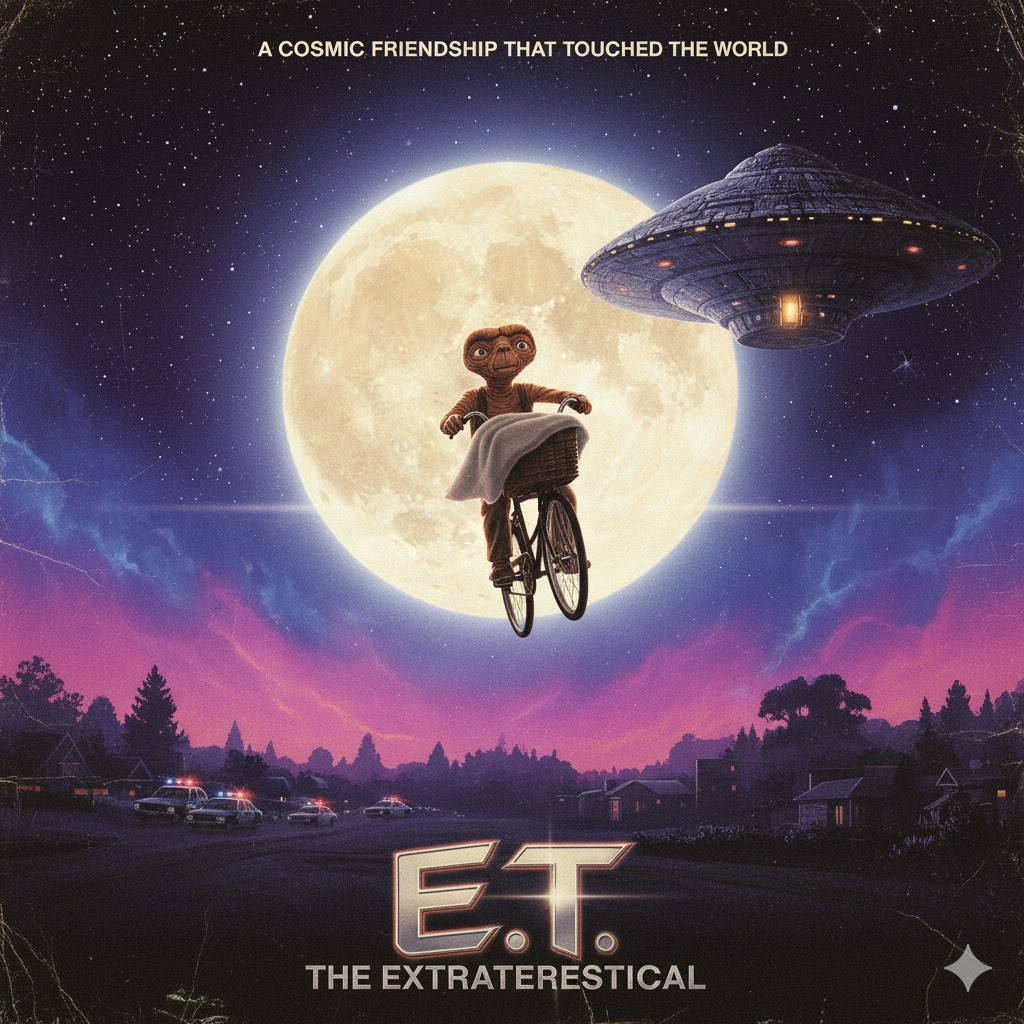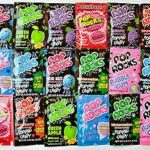 Few candies captured the imagination of children and teenagers in the 1980s quite like Pop Rocks. Unlike ordinary sweets, this fizzy confection delivered a multisensory experience: the popping and crackling on the tongue, the surprising sensation that seemed to defy logic, and the bright, colorful packaging all contributed to an unforgettable treat. More than just a candy, Pop Rocks became a cultural touchstone of the decade, influencing everything from advertising trends to music videos, television, and even the way kids interacted with novelty foods. Its presence in the 1980s represents a moment when candy could be entertainment, spectacle, and social currency all at once.
Few candies captured the imagination of children and teenagers in the 1980s quite like Pop Rocks. Unlike ordinary sweets, this fizzy confection delivered a multisensory experience: the popping and crackling on the tongue, the surprising sensation that seemed to defy logic, and the bright, colorful packaging all contributed to an unforgettable treat. More than just a candy, Pop Rocks became a cultural touchstone of the decade, influencing everything from advertising trends to music videos, television, and even the way kids interacted with novelty foods. Its presence in the 1980s represents a moment when candy could be entertainment, spectacle, and social currency all at once.
Pop Rocks first appeared on the U.S. market in 1976, invented by General Foods chemist William A. Mitchell, who had a knack for creating unusual food innovations. The candy’s secret was its unique manufacturing process: carbon dioxide gas was trapped inside sugar crystals under high pressure. When the candy dissolved in the mouth, the gas was released, creating the signature popping and crackling sensation. This process seemed almost magical to children, creating the illusion that candy could come alive on the tongue. While it took a few years for the candy to gain mass popularity, by the early 1980s, Pop Rocks had become a staple in convenience stores, school lunchboxes, and neighborhood candy stores across the United States.
What made Pop Rocks particularly impactful in the 1980s was not just its novelty but its alignment with the sensory-driven, attention-grabbing culture of the decade. The 1980s were defined by bold colors, flashing lights, and heightened consumer spectacle. From neon fashion to music videos on MTV, the decade favored products and experiences that stood out and left a lasting impression. Pop Rocks fit perfectly into this landscape, offering a candy-eating experience that was active, loud, and surprising. Unlike chocolate or gum, which could be enjoyed passively, Pop Rocks demanded attention. The popping noises became a social performance; kids would gather in groups to hear the crackle, compare flavors, or prank each other with the startling effect of the candy.
Television advertising played a crucial role in embedding Pop Rocks into 1980s pop culture. Commercials emphasized the explosive fun of the candy, often depicting children reacting with astonishment and laughter as their mouths fizzed and popped. These ads leaned into the novelty factor, portraying Pop Rocks not just as a treat but as a magical, almost futuristic confection. The candy’s marketing tapped directly into the decade’s fascination with kinetic energy and entertainment, framing the act of eating as a playful, shared experience rather than a solitary act. Pop Rocks commercials were memorable, and their energetic, over-the-top style mirrored the broader tone of 1980s television advertising, which favored excitement and immediate engagement.
Pop Rocks also infiltrated music and teen culture, often appearing in the hands of young characters in movies, TV shows, and even music videos. The candy’s association with youthful exuberance and rebellion was subtle but effective. For example, its brief appearance in popular teen-oriented films signaled a character’s fun-loving personality or their connection to contemporary trends. Similarly, in music videos of the early MTV era, candy like Pop Rocks symbolized the playful, slightly irreverent spirit of youth, aligning perfectly with the visual and auditory spectacle of the new medium. The candy became shorthand for childhood freedom, experimentation, and delight—a microcosm of the decade’s emphasis on pleasure and immediacy.
The social dimension of Pop Rocks consumption cannot be overstated. Eating the candy became a shared experience among schoolchildren and neighborhood friends. Kids would challenge each other to see who could handle the most, experiment by combining flavors, or prank siblings by adding unexpected amounts to drinks (despite urban legends suggesting dangerous interactions with soda, which were largely exaggerated). The candy encouraged experimentation and risk-taking in a safe, contained form, reflecting broader trends in 1980s youth culture, which celebrated individuality, boldness, and sensory exploration. Sharing Pop Rocks was not just about the candy itself but about the social bond it fostered, the laughter it produced, and the stories it generated—“Remember that time we tried Pop Rocks and soda?” became a common refrain among friends.
Another reason Pop Rocks became so influential was the sense of wonder it inspired. The candy’s crackling reaction was novel enough to spark curiosity about science, chemistry, and cause-and-effect relationships. While marketed purely as a fun treat, Pop Rocks inadvertently encouraged a rudimentary scientific mindset. Children observed reactions, made hypotheses, and tested them in playful ways. This merging of education, entertainment, and snackability perfectly mirrored the edutainment trend of the 1980s, in which toys, shows, and games often blended fun with subtle learning opportunities. Pop Rocks fit seamlessly into a culture that valued interactive, engaging experiences, positioning itself as a candy that was intellectually intriguing as well as sensorially delightful.
The flavor variety and packaging of Pop Rocks also played a role in cementing its cultural status. Brightly colored packets in strawberry, cherry, grape, orange, and watermelon appealed to the decade’s love of bold, eye-catching aesthetics. The small, portable packaging made it ideal for school lunches, pocket stashing, and sharing among friends, creating a sense of candy as a social accessory. Kids weren’t just eating a snack; they were performing a ritual, producing an audible spectacle that drew attention and admiration from peers. Pop Rocks became part of the social fabric, woven into the shared experiences of schoolyards, birthday parties, and neighborhood hangouts.
One of the most fascinating aspects of Pop Rocks’ impact on 1980s pop culture was its association with urban legends and myths. Stories circulated that mixing Pop Rocks with soda could make someone’s stomach explode—a rumor that was entirely false but nonetheless added an aura of risk and excitement. Such myths made the candy feel dangerous, rebellious, and edgy, enhancing its appeal to adventurous youth. The exaggeration of its effects mirrored broader trends in 1980s media, which often emphasized sensationalism, spectacle, and over-the-top experiences. Pop Rocks thrived not just because it was novel but because it became embedded in the storytelling and folklore of childhood, providing a shared cultural reference that transcended the candy itself.
The candy’s legacy in pop culture was further amplified by celebrity endorsements and media appearances. While not always formally sponsored, Pop Rocks became a recurring motif in shows, commercials, and films aimed at children and teenagers. Its inclusion in movies, such as scenes depicting teen fun or playful chaos, reinforced the candy’s association with the carefree energy of the 1980s. By the end of the decade, Pop Rocks had established itself not merely as a novelty candy but as a symbol of a particular era—one in which sensory thrills, bright colors, and interactive fun dominated the cultural landscape.
Pop Rocks’ influence can also be seen in the way it helped define the novelty candy market. The success of this explosive treat encouraged other candy makers to experiment with unusual textures, popping sensations, and interactive experiences. It inspired a wave of candies that emphasized action and performance over traditional taste profiles, reflecting a shift in children’s desires during the 1980s: to be entertained and engaged by what they consumed, not merely nourished or satisfied. The candy’s playful, experimental nature mirrored the decade’s broader cultural ethos, characterized by innovation, exaggeration, and the embrace of sensory spectacle.
The enduring legacy of Pop Rocks extends beyond nostalgia. For those who grew up in the 1980s, the candy represents a vivid sensory memory, recalling afternoons spent laughing with friends, performing small experiments, and delighting in the unexpected crackle of candy that seemed almost magical. It serves as a reminder of a time when consumer products were designed to be playful, surprising, and interactive, and when youth culture embraced the extraordinary in everyday life. Pop Rocks, in its simplicity and ingenuity, captured the essence of 1980s childhood—a period of invention, excitement, and shared experience.
Even decades later, Pop Rocks continues to evoke the thrill of its original audience. Retro candy stores, nostalgia-themed marketing campaigns, and pop culture references keep the brand alive, connecting new generations with a piece of 1980s history. The candy’s cultural impact is measurable not only in its continued presence on store shelves but in its role as a symbol of a decade that celebrated playfulness, curiosity, and sensory engagement. It demonstrates how even a small, pocket-sized product can leave an outsized imprint on collective memory, proving that fun and innovation often go hand in hand.
Ultimately, Pop Rocks’ significance in 1980s pop culture lies in its ability to combine sensory stimulation, social interaction, and novelty in a way that resonated with children and teenagers alike. It was more than candy; it was a shared experience, a conversation starter, and a tool for experimentation and play. The explosive reactions, bright colors, and playful mythology surrounding Pop Rocks made it emblematic of the decade itself—a period defined by bold choices, interactive media, and a fascination with spectacle. For anyone who grew up tasting the crackle, the candy remains a symbol of youthful exuberance, creativity, and the joy of discovering something that seemed to come alive in your hands.
Pop Rocks’ story exemplifies how a simple product can intersect with larger cultural trends to create a phenomenon. It capitalized on the decade’s love of boldness, spectacle, and shared experience, becoming a staple of childhood nostalgia and a reference point in the broader cultural memory of the 1980s. The candy was never just about flavor; it was about performance, surprise, and delight—a miniature explosion that perfectly captured the energy of a transformative decade. Its continued presence in popular culture underscores the power of novelty, the appeal of interactive experiences, and the enduring charm of a product that literally made children’s mouths pop with excitement.
For the generation that grew up with it, Pop Rocks is more than a candy—it is a cultural artifact, a sensory memory, and a reminder of the ways in which play, experimentation, and imagination defined a formative era. Its place in the pantheon of 1980s pop culture is secure, alongside neon fashions, arcade games, and iconic TV shows. Pop Rocks represents a moment when a tiny, crackling candy could capture the spirit of a decade, leaving a lasting imprint on the taste buds, ears, and imaginations of children across the country.
